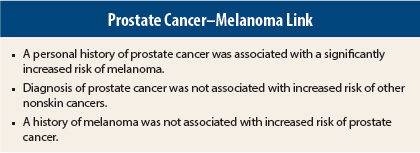History of severe acne, which is a surrogate for high androgen activity, has been associated with increased risk of prostate cancer, and recent data suggest that severe teenage acne is a risk factor for melanoma. Such findings suggest a role of androgens in etiology for both prostate cancer and melanoma.
In a study reported in the Journal of Clinical Oncology, Wen-Qing Li, PhD, of the National Cancer Institute, and colleagues investigated the potential association between prostate cancer and melanoma in white men.1 Their findings suggest that personal history of prostate cancer is associated with significantly increased risk of melanoma.
Study Details
The study was a prospective evaluation of the association of prostate cancer and incident melanoma among 42,372 white men in the Health Professionals’ Follow-Up Study (HPFS, 1986–2012). Prostate cancer, melanoma, and nonmelanoma skin cancer diagnoses were self-reported biennially, and prostate cancer and melanoma diagnoses were pathologically confirmed. The association between prostate cancer diagnosis and melanoma was also examined among 18,603 white men in the Physicians’ Health Study (PHS, 1982–1998).
Increased Risk of Melanoma in HPFS
During 747,176 person-years of follow-up, 5,091 prostate cancers and 539 melanomas were identified in the HPFS. Men with prostate cancer were older (mean, 73 vs 61 years) and reported greater ever-use of sildenafil citrate for erectile dysfunction (24% vs 5.5%). They were also somewhat more likely to have greater sun exposure (average ≥ 11 hours per week in 56.5% vs 50% in college/high school, 39% vs 32% at age 25–35 years, 31% vs 27% at age 36–59 years, and 32% vs 27% at age ≥ 60 years) and somewhat less likely to be a current smoker (4.5% vs 7.6%). Burn or blistering due to sun exposure was reported in 65% and 68%, 4.7% vs 3.7% had a family history of melanoma, natural red or blonde hair was reported in 15% vs 13%, and history of at least six severe or blistering sunburns was reported in 36% and 34%.
On multivariate analysis adjusting for age, body mass index, smoking status, alcohol intake, physical activity, ever-use of sildenafil citrate for erectile dysfunction, childhood reaction to sun, number of sunburns, mole count, hair color, family history of melanoma, sun exposures by age, and ultraviolet (UV) index by age, personal history of prostate cancer was significantly associated with increased risk of melanoma (adjusted hazard ratio [HR] = 1.83, 95% confidence interval [CI] = 1.32–2.54). A lag analysis in which prostate cancer diagnosis occurring at least 2 years before melanoma served as the exposure produced similar results (HR = 1.54; 95% CI = 1.03–2.29).
Adjustment for midrange UV radiation exposure (UVB flux) and adjustment for severe acne also did not alter the association. Mole counts were not significantly related to risk of prostate cancer, although there was a borderline significant interaction (P = .08 for interaction) between prostate cancer and melanoma risk according to presence of moles. No significant heterogeneity in melanoma risk was found in analyses by prostate cancer subtype, age at diagnosis, or primary treatment.
During 692,290 person-years of follow-up, 11,960 nonmelanoma skin cancers (squamous cell or basal cell carcinoma) were identified in the HPFS. Patients with prostate cancer had a slight and nonsignificant increase in risk for nonmelanoma skin cancers (adjusted HR = 1.08, 95% CI = 0.995–1.16). The magnitudes of association of prostate cancer with melanoma and with nonmelanoma skin cancers were significantly different (P =.002 for heterogeneity).
Personal history of melanoma was not associated with increased risk of prostate cancer (HR = 0.88, 95% CI = 0.57–1.35).
No Increased Risk of Other Cancers
Personal history of prostate cancer was not significantly associated with risk of other cancers (eg, HR = 1.23, 95% CI = 0.96–1.57, for lung cancer, and HR = 1.16, 95% CI = 0.82–1.63, for colorectal cancer).
Risk for melanoma was not significantly associated with history of cancers other than prostate cancer, with few patients with other major cancers developing melanoma during follow-up (eg, three patients with colorectal cancer and none with lung cancer).
Confirmation in PHS Cohort
The association between prostate cancer diagnosis and increased risk for melanoma was confirmed in the PHS cohort, in which 166 melanomas were identified in 251,850 person-years of follow-up.
In a multivariate analysis adjusting for age, body mass index, smoking status, alcohol intake, and physical activity, the hazard ratio for melanoma in patients with history of prostate cancer was 2.17 (95% CI = 1.12–4.21). For both cohorts combined, the hazard ratio was 1.89 (95% CI = 1.41–2.54).
The investigators concluded:
[B]ased on two large, well-established, long-term cohorts, we suggest an association between a diagnosis of [prostate cancer] and risk of subsequent melanoma in white men, which may not be entirely a result of greater medical scrutiny. We postulated a potential role for androgens in the etiology of melanoma, which might contribute to the observed association. Pending biologic investigation, further understanding of the mechanisms that mediate the associations could eventually lead to elucidation of new targets for interventions that may modulate their incidence or activity…. Our finding of [prostate cancer] diagnosis as a risk predictor for melanoma holds general public health significance, which may inform clinical practice to address the queries and aid the care of patients with [prostate cancer].
They noted that it would be of interest to investigate the effects of continuous androgen deprivation in prostate cancer on the risk for melanoma. ■
Disclosure: The study was supported by the National Cancer Institute. The authors reported no potential conflicts of interest.
Reference
1. Li W-Q, Qureshi AA, Ma J, et al: Personal history of prostate cancer and increased risk of incident melanoma in the United States. J Clin Oncol 31:4394-4399, 2013.



